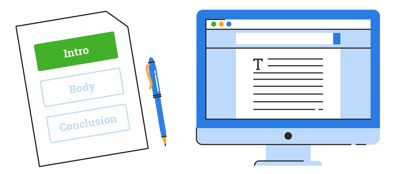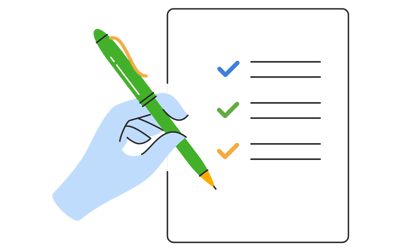
7 Factors You Can Use to Measure the Effectiveness of Writing Instruction
You know it's important to teach writing. Here are a few ways to track whether students are making progress.
Like so many essential skills, learning how to write is a multi-year process. To produce a strong piece of writing, students need a foundation in grammar, vocabulary, and sentence structure. Then, they need to construct a cohesive argument or arc to their writing. They must understand their audience, and be able to employ language that resonates with that audience. In advanced writing, students must also anticipate and respond to critiques, distill complex information in approachable terms, and keep a reader engaged throughout the piece.
With so many skillsets contributing to an effective piece of writing, it can be difficult to teach writing, let alone assess the effectiveness of that teaching.
Luckily, teachers and administrators have a handful of resources available at their disposal to measure the effectiveness of writing instruction. By analyzing data, discussion, student confidence, and more, educators can pull together insights that reveal how students have progressed in writing—and where they may need some extra help advancing their skills.

1. Writing samples at the beginning and end of year
At ThinkCERCA, we encourage teachers to assign beginning-of-year, mid-year, and end-of-year writing assessments. The idea is simple: by assessing writing at certain checkpoints throughout the school year, teachers can get a clear view into how the quality of students' writing has progressed. When the writing samples are far apart (for instance, separated by a semester or an entire year of instruction) the changes in writing will be more obvious.

2.Quality of student discussion
There's a reason that literacy encompasses speaking, reading, and listening in addition to writing. Speaking and listening are important methods of sorting through ideas and consuming complex information. When students discuss an issue or argument with their peers, they can employ the same mechanics they apply to a piece of writing: claim, evidence, reasoning, counterarguments, and audience-appropriate language.
At ThinkCERCA's recent webinar, Strategies to Implement Writing Across the Curriculum, Panelist and Instructional Coach Brooklyn Joseph shared an anecdote about how student discussion illuminated the degree to which writing instruction had impacted her students:
We do a lot of field learning and take students on field trips. And last year, on one of our field trips, the educators who were leading the trip who worked for the Parks Department asked the students a couple of questions. And when they told us the story later, they said, "We were so amazed by the depth of the student responses." And they even mentioned that the students were referring to each others' arguments with the CERCA Framework.
So, for example, a student mentioned to another student, "Well, that doesn't make sense because I don't see where you're getting your evidence from our lab." And then, another student would say, "Oh. Well, I guess I didn't explain my reasoning well enough." And then, another student would follow up and say, "Well, I do have a counterargument for that reasoning because of this."
They were using those frames to guide their discussion in the field. And I think that is a true measure of success in terms of using this format: students feeling comfortable with it.

3. Students' confidence in their writing
If students feel confident in the writing they complete, it stands to reason that they were well-equipped and prepared to produce the writing. If students feel concerned about their writing, however, it's an indicator to teachers that additional or more targeted writing instruction could be valuable for students.
To quickly assess confidence in writing, you can ask students to mark on a slip of paper—when they leave class or when they turn in an assignment—how confident they fill in their writing, on a scale from one to five.

4. Students' confidence in their ability to give feedback on writing
Similarly, once students have developed a strong writing habit, they should feel confident in their ability to analyze the writing of others. By engaging in peer discussion, students can also hone their arguments and practice responding to differing points of view.

5. Summative Assessments
Teachers can gauge the impact of a day's writing instruction with summative assessments. These assessments—which can take the form of exit tickets, quick writes, quizzes, and more—will reveal the degree to which students comprehended the objective of the day's lesson. These insights can be especially valuable, as they break down writing instruction into discrete parts as separated by lesson, class, or day.

6. State assessments
State assessments provide a high-level overview of student writing progress and literacy achievement. It's worth noting, however, that some states assess writing every few years (for instance, once in fourth grade and once in seventh grade, but not in-between) which can complicate year-over-year comparisons.
Some districts have found that by using assessments that analyze student performance at the beginning, middle, and end of year, they can more quickly assess the impact of writing instruction.
At Youngstown City School District in Ohio, for instance, administrators were able to compare beginning-of-year and mid-year results on the NWEA MAP assessment. During this time, the school district had also implemented a writing across the curriculum initiative with ThinkCERCA. The mid-year MAP results revealed that students who submitted five or more ThinkCERCA Writing Lessons demonstrated more than twice the growth in RIT (reading growth) scores than students who did not submit a Writing Lesson.

7. Data from ed-tech tools
Finally, data from ed-tech tools can provide administrators and teachers with a clear view into student writing progress and, therefore, the effectiveness of writing instruction. When shared with students, this data can also help motivate students to monitor their progress with writing.
Ed-tech data can also reveal trends about writing instruction at the class, grade, school, and district level, week-by-week or year-over-year. With the variety of reports available, make sure to use a tool that incorporates writing and has systems to track writing scores and progress.
Interested in scaling writing instruction? Continue your learning with the "Writing to Learn" webinar >>

Mallory Busch is ThinkCERCA's Editor of Content Strategy. A graduate of Northwestern University, Mallory came to ThinkCERCA from stops in audience strategy at TIME magazine and news applications development at Chicago Tribune and The Texas Tribune. She holds degrees in Journalism and International Studies, and was a student fellow at Knight Lab in college.

